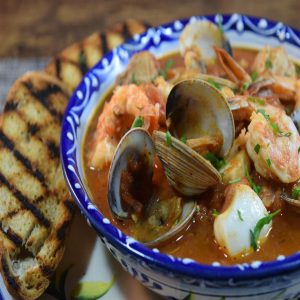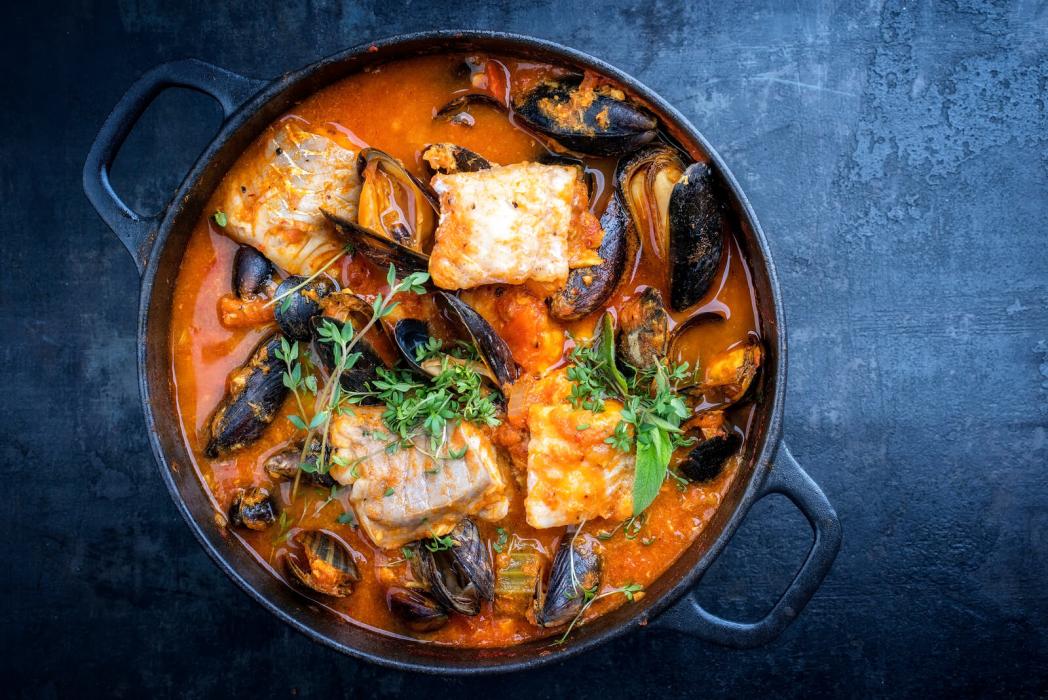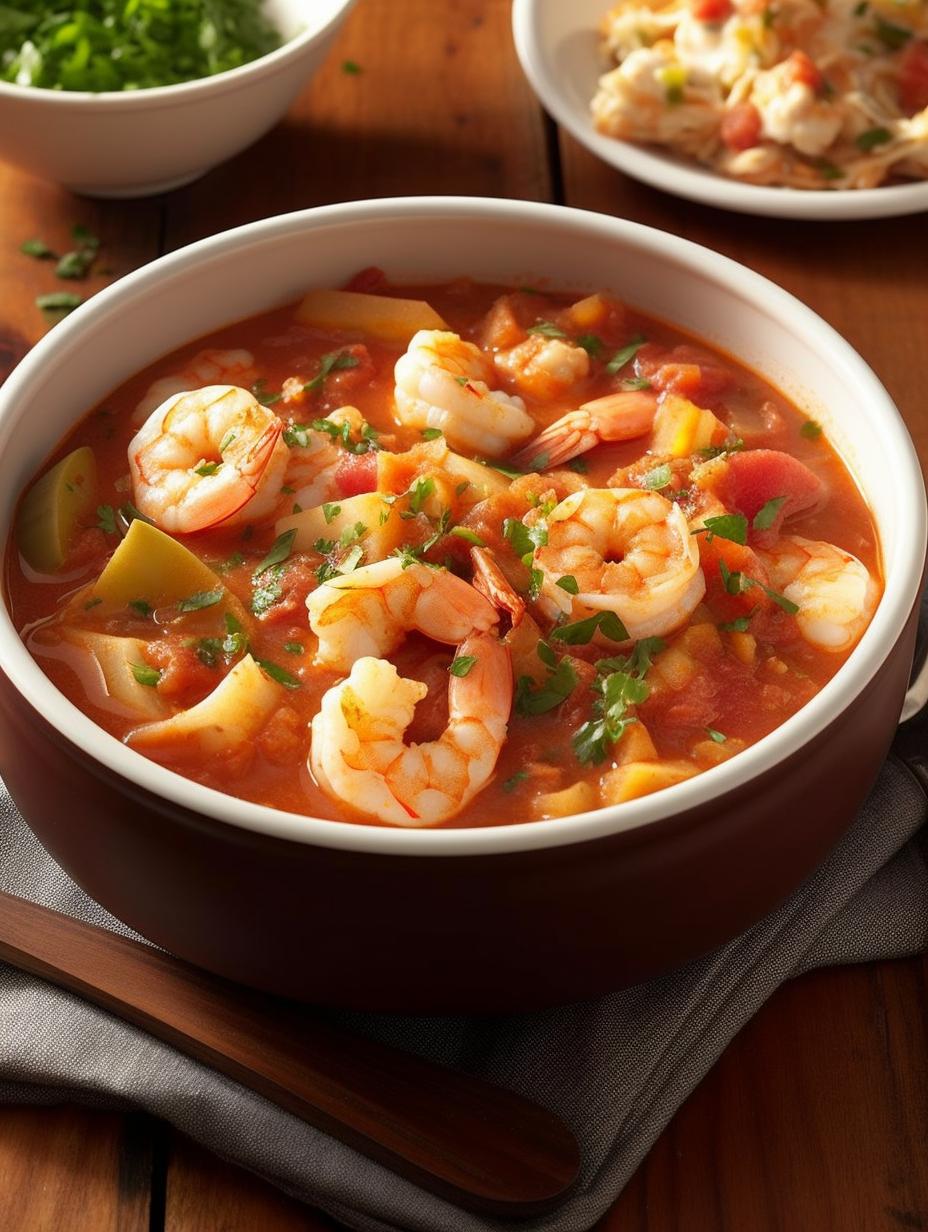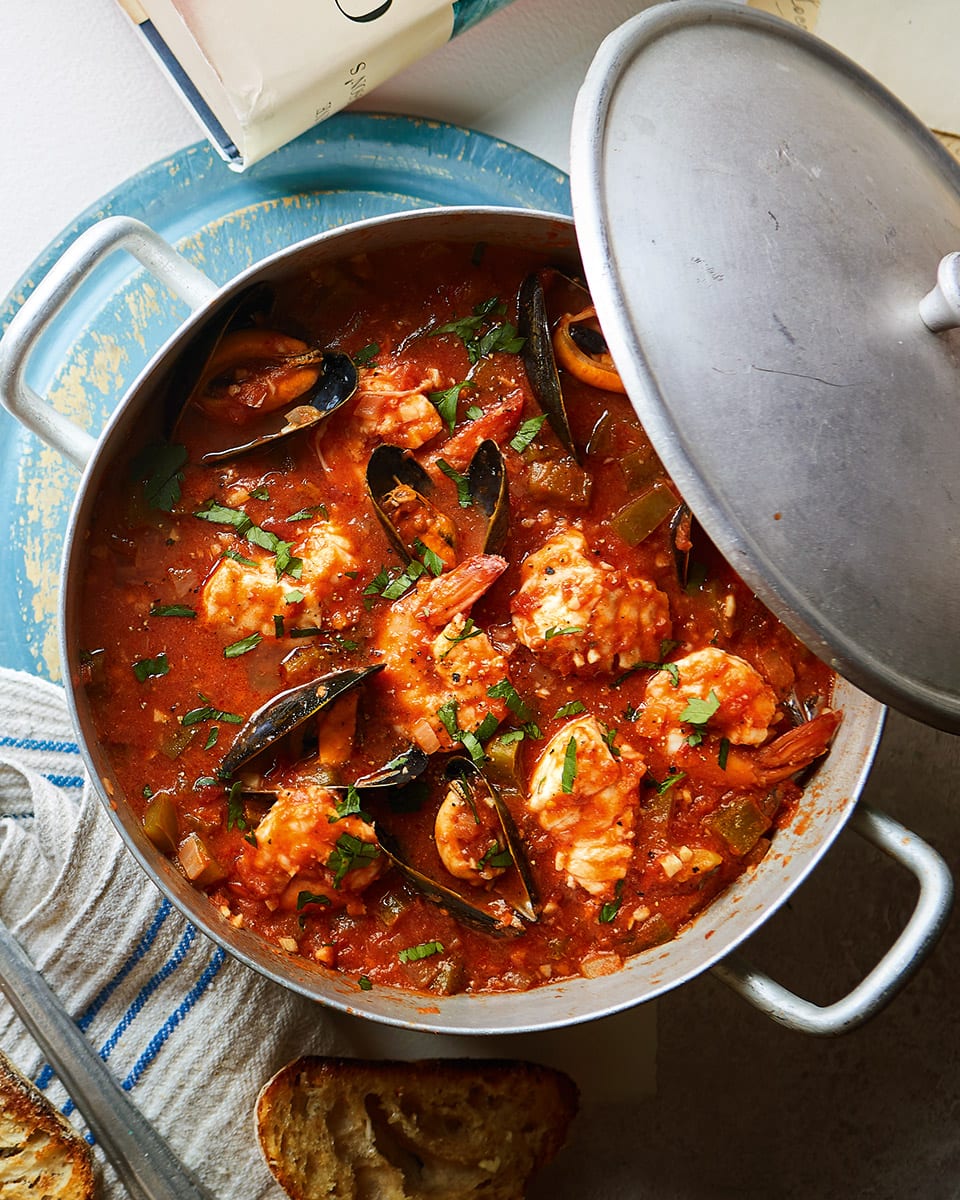During my travels, I encountered a dish that perfectly captures the essence of the Mediterranean Sea’s bounty: Mediterranean Seafood Stew. This exquisite delicacy, composed of tender sea bass fillets simmered in a rich broth made from ripe plum tomatoes and aromatic vegetable stock, truly embodies the vibrant flavors of the region. Each spoonful of this stew offers a taste of the sea, complemented by the sweetness of the tomatoes and the depth of the vegetable broth, creating a harmonious blend of flavors that linger on the palate. Inspired by this discovery, I ventured to recreate this culinary masterpiece at home. After much experimentation and refining, I’ve managed to encapsulate the essence of the Mediterranean into a recipe that is both authentic and inviting. I’m thrilled to share this Mediterranean Seafood Stew with you, allowing the fresh, robust flavors of the sea to transport you to those very shores, all from the comfort of your kitchen.

Mediterranean Seafood Stew
Equipment
- 1 large mixing bowl
- 1 Dutch oven
Ingredients
- 3 tablespoon toasted pine nuts
- Crusty Italian bread
- 2 lb. skinless sea bass fillet
- 1/2 cup fresh parsley leaves
- Olive oil
- 1/4 cup golden raisins
- 2 tablespoon capers
- 1 large yellow onion
- 1 28- oz. can plum tomatoes
- 3 cups vegetable broth
- Pinch red pepper flakes
- 3/4 cup dry white wine
- 2 celery ribs
- 4 large garlic cloves
- 1/2 teaspoon dried thyme
- Salt and pepper
Instructions
- 1 tablespoon olive oil, heated over moderate flame.
- Add the onions, fennel, and a pinch of salt and pepper to taste.
- Cook for a few minutes until the thyme, red pepper flakes, and cloves are aromatic.
- Decrease the fluid by about 1⁄2 percent by getting it to a simmer.
- Combine the peppers, vegetable broth, pecans, and chives in a large mixing bowl.
- Cook for 15-20 minutes over a moderate flame, stirring periodically until the flavors have melded.
- Place the fish parts in the liquid ingredients and gently stir them all together. Cover the Dutch oven and turn off the heat.
- Mix in the chopped parsley last.
- Fill serving bowls halfway with the spicy fish stew.
Cooking tips about Mediterranean Seafood Stew

- Selecting Seafood: Freshness is paramount when it comes to seafood. For a Mediterranean stew, consider a mix of shellfish (like clams and mussels), firm white fish (such as sea bass or cod), and even squid or shrimp. Each component should smell of the sea, not fishy, indicating its freshness.
- Searing Seafood: To introduce depth of flavor, consider searing larger pieces of fish before adding them to the stew. This technique provides texture and enriches the broth with a concentrated seafood essence. However, be mindful not to overcook; just a quick sear will suffice.
- Flavorful Foundations: Begin your stew with a sofrito—a sautéed mixture of onions, garlic, bell peppers, and tomatoes. This Mediterranean aromatic base is crucial for building the stew’s depth of flavor. Cook these elements until they’re softened and fragrant before adding any liquids.
- Herbs and Spices: Incorporate classic Mediterranean herbs like parsley and oregano, and don’t forget a pinch of saffron for that iconic color and taste. These seasonings should complement the seafood without overpowering its natural flavors.
- Deglazing with Wine: Deglaze your sofrito with a splash of good quality white wine, scraping up the flavorful bits from the bottom of the pan. This process adds an acidic brightness that balances the seafood’s richness.
- Simmering Slowly: After adding your broth and bringing the stew to a simmer, add your seafood in stages based on cooking times—start with those that take the longest to cook and end with the most delicate, like shellfish, which only need a few minutes.
- Vegetable Add-Ins: Besides the traditional sofrito, consider adding diced potatoes or carrots for heartiness. These should be added early enough to cook through but maintain some bite for texture.
- Adjusting Consistency: If your stew needs thickening, a spoonful of tomato paste can add richness and body. Alternatively, removing the lid and letting it simmer gently can reduce the liquid to the desired consistency.
- Tasting and Adjusting Seasonings: Before serving, taste your stew and adjust the salt, pepper, and acid levels as necessary. A squeeze of fresh lemon juice can brighten the overall flavors beautifully.
Serving suggestions about Mediterranean Seafood Stew

- Use Rustic, Shallow Bowls: Serving the stew in rustic, wide bowls not only enhances its visual appeal but also makes it easier for guests to enjoy every component of the stew, from the succulent seafood to the flavorful broth.
- Garnish with Fresh Herbs: A sprinkle of fresh parsley or a few leaves of basil can add a pop of color and a burst of freshness to the dish. It’s a simple addition that complements the rich flavors of the stew beautifully.
- Offer Crusty Bread on the Side: No Mediterranean Seafood Stew is complete without a side of crusty, artisan bread. It’s perfect for dipping into the luscious broth, ensuring that your guests can savor every last drop.
- Pair with a Light White Wine: Choose a white wine that balances the hearty, spiced nature of the stew. A crisp, light-bodied wine, such as Pinot Grigio or a dry Vermentino, pairs beautifully, enhancing the seafood flavors without overwhelming them.
- Serve on a Table Adorned with Mediterranean Accents: Decorate your dining table with elements inspired by the Mediterranean Sea – think blue and white linens, terra cotta dishware, and simple, elegant flatware. This themed setting will transport your guests to a seaside escape, enhancing the overall dining experience.
- Lemon Wedges for a Citrusy Zest: Offering lemon wedges on the side allows your guests to add a squeeze of lemon juice to their stew if desired. This touch of acidity can brighten the flavors and add an extra layer of complexity.
- Finish with a Light Dessert: After the rich flavors of the seafood stew, opt for a light and refreshing dessert. A citrus sorbet or a fruit tart would be the perfect palate cleanser and conclusion to a Mediterranean-inspired meal.
Top 5 FAQs about Mediterranean Seafood Stew

- What types of seafood are best for Mediterranean Seafood Stew? The beauty of Mediterranean Seafood Stew lies in its versatility. Ideally, a mix of shellfish like clams and mussels, firm white fish such as sea bass or cod, and more delicate options like squid or shrimp create a harmonious blend of textures and flavors. Selecting seafood that is fresh and of good quality is crucial for achieving the stew’s signature taste.
- Can I use frozen seafood for the stew? Yes, frozen seafood can be used, especially when fresh options are not available. Ensure that it’s completely thawed and properly pat dry before cooking to avoid adding excess water to your stew. Remember, the timing may need to be adjusted as frozen seafood can cook differently than fresh.
- What is the base broth made of, and can it be substituted? The base broth typically uses a combination of ripe plum tomatoes and aromatic vegetable stock, which provides depth and richness to the stew. For substitutions, a light fish stock can also be used for an even deeper ocean flavor. Adding wine can introduce an acidic brightness that complements the seafood perfectly.
- How can I thicken the broth if it’s too runny? If your stew is more liquid than desired, you can thicken it by simmering it uncovered to reduce the broth. Alternatively, a small amount of tomato paste can enrich and thicken the sauce without overpowering the delicate seafood flavors.
- What are some serving suggestions for Mediterranean Seafood Stew? Serve your stew in wide, shallow bowls to highlight its colorful array of ingredients. Garnishing with fresh parsley or a sprinkle of lemon zest adds a fresh burst of flavor. Accompaniment with crusty bread is essential for dipping into the savory broth, making no drop go to waste. Pairing the stew with a light-bodied white wine, such as a Pinot Grigio, can enhance the meal beautifully.
As we conclude our journey with the Mediterranean Seafood Stew, it becomes clear that this dish is more than a simple concoction of seafood and broth; it’s a celebration of the Mediterranean’s abundant seas and rich culinary traditions. With every spoonful, we savor the freshness of the sea bass, the sweetness of plum tomatoes, and the aromatic depth provided by the meticulously prepared vegetable stock. This stew, born from a blend of quality ingredients and seasoned with the vibrant flavors of the Mediterranean palette, embodies the essence of coastal cuisine—fresh, invigorating, and deeply satisfying.

Leave a Reply